Runners choice, The 8-map format and Score-o sections – three different mass start spreading methods with a lot in common have surfaced in the orienteering community lately. I have received several emails about these methods – and some of them have also been discussed in several forums – thus I decided to present them briefly here. Can any of these – or another spreading method using elements from one/several of them – be the future spreading method in a mass start or chasing start event in the World Championships?
There will probably be either a mass start or a chasing start in future World Championships – see this article for some background info and discussion. As discussed in the article, none of the presently used spreading methods for mass starts seem to have what is needed to fulfill the requirements for fairness, spreading and spectator/TV/GPS-friendliness. Three methods have recently been suggested/discussed. These methods are briefly introduced below – with links to more information about them. What do you think about these methods?
Runners choice
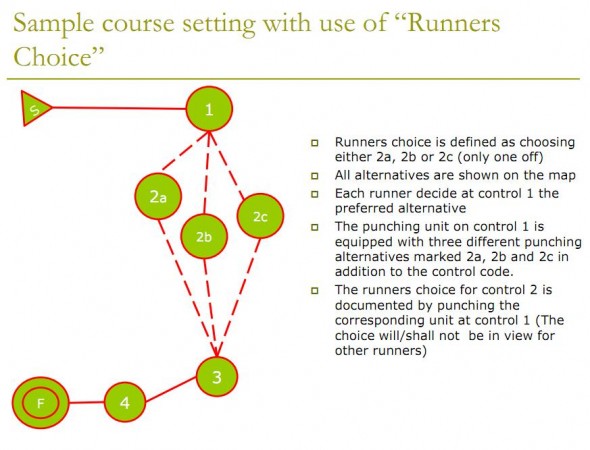
The Runners choice method was suggested by Tore Sagvolden at the NORD meeting in January. According to an article at orientering.no (Norwegian language), this method has been developed for 1-2 years. The thought behind the method is that one shall have a mass start in a World Championship race, and the runners shall still have to orienteer independently. – I think this is both exciting and challenging for the runner, and at the same time I think they will experience it as fair, Sagvolden explains to orientering.no. – The goal is to test drive the spreading method in competition this sprint, to make it possible to discuss it at the president meeting of the IOF during WOC in France this summer.
The above illustration given an example of the method in use. It is based on the runner choosing one of three alternatives when approaching a common control (control 1 in the illustration above). You can see more details about the method in this powerpoint presentation. The method has been discussed in detail at Alternativet.nu.
The 8 map format
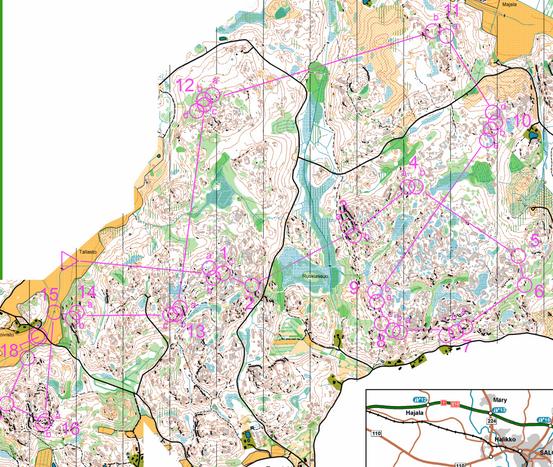
The 8 map format was suggested by “Mr Routegadget”, Jarkko Ryyppö already more than half a year ago at a discussion at Attackpoint.org. Jarkko has now further detailed it, and set up an example course. The method can be described as follows (taken from here):
- Mass start, each runner gets 8 maps at start. They need to pick one and drop the rest. They can use as much time as they like, but time is ticking and they can also pick any map and start immediately. Those dropped 7 maps are scanned with bar code reader right after the start, so TV speakers / GPS tracking web spectators will know what spreading each runner is on.
- To make co-operation and code yelling during the race slightly more difficult two sets of codes can be used. Aka at each control there is two codes, like 64 and 72. You have 72 in your map and your friend has 64, you can’t tell just by the code will you have the same or not.
- Objective is to figure out new, GPS tracking friendly, fun and reasonably fair mass start format. The idea here is to keep keep runners close together and have lots of spreading controls, so runners can’t never be sure the pack is going to the right control. And if it goes to wrong one he can’t see where it is, spreading controls are not printed on his map.
Score-o sections
In the article about mass start in WOC I suggested a method using sections of “score-o”. This method was actually partly inspired by the “Runners choice” method of Sagvolden which I had heard something about prior to writing my suggestion.
The method can be described as follows:
- One possible scenario would be to have several score-o sections on the course, e.g. one early in the race and one in the middle of the race.
- The score-o sections should be held quite short. The important thing: The runners should have to choose the order to take the controls on in this section based on their own judgement only – before entering that section. This would not give the same situation as in a relay, but at least the competitors would not know if their next control is the same as their rivals for these parts. Technically this could be done by choosing from e.g. a set of pre-defined courses A-E which each have the score-o controls in a different order.
- Taking it a step further, you could introduce a set of pre-defined courses A-E – not even being defined by the same controls (-> this can actually be the “Runners choice” method)
Summary
Three methods in which the runner chooses which controls to take – are any of these any good? Personally I see some issues with all of them, but I think most of the issues should be solvable. What do you think? Does any of these methods have potential? Please try to look beyond the issues, and try to see possibilities instead of problems (I know it is tempting to bash all the methods…).
For now don’t think of it as a method for the World Champs – rather think of it as a spreading method for more of a “show type race” optimized for TV/spectators – like for example one leg of a future “Nordic Orienteering Tour”… Can you see any of these methods used in the Nordic Orienteering Tour or in a “Show race” optimized for TV?
 World of O News
World of O News
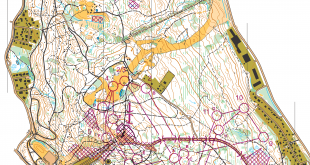
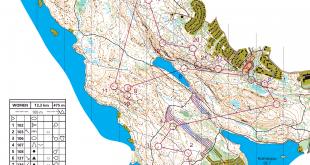
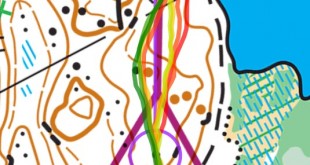
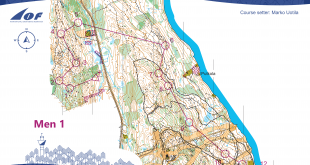
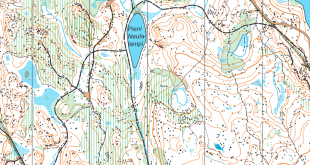
The 8 map method seems to me very much like Macr-O which had very low acceptance among the runners. The main difference being that you can spend some time looking at the map and deciding which controls you prefer. I don’t think a bunch of runners standing at the start look at a heap of maps to decide which to take will make good TV-entertainment.
The score-o has been used for years. The main problem seems to be that there really are only one or two sensible orders to take the controls in any real situations.
Runners choice could give some interesting alternatives, instead of being relatively similar and thus difficult to chose between one could make the three controls very different. Long easy vs short and technical. The runners would to an even larger degree have to know their own strengths and weaknesses.
About the score-o method, the difference here compared to what is in use today is that runners must choose ahead of coming to the control. But I agree that there being only one or two sensible orders is a potential problem. Would be interesting to test it out, though. However, I think that Runners choice might be a better method.
About the 8 map method, the difference to Macro is that this is a choice by the runners, and therefore potentially could have higher acceptance. On the other hand, if the choice must be made based on not being able to analyze the options properly (i.e. leaving it to chance), I agree that it gets closer to Macr-O. BTW, I still think Macr-O has interesting potential, and could have been alive if it had been introduced in a different way.
About Runners choice, the potential along the lines you describe is interesting – the challenge is to make options which give a spreading on the different alternatives I’d guess. They should probably be looking very equal in order to ensure a good distribution…
Runner’s choice requires at least some way to properly hide what each runner is selecting (voting booth/tent tunnel?), and it is of course dead easy for friends to discuss the proper selection before they get there, unless you also have a map change at the same spot, i.e. with no time to study the alternatives.
Without a map change, but with multiple control codes, you can still discuss alternatives, by simply saying “I like the left alternative” or even up front “taking the middle alterantive is almost always the shortest”.
The real main problem with Runner’s choice is that, as has been noted above, you have to make sure that the alternatives looks as equal as possible, on the map:
This means that any actual difference in the forest will be a pure luck element, which is something that should be anathema to any course planner.
OTOH, with 3 identical alternatives, the mass start group, including the top runners, will split more or less evenly, and they will all meet up at the next control with very little difference in time.
So, what do we want?
1. Regarding the “hidden choice”, that should be easy to implement by letting the alternatives have different letters on the different maps, coded by startnumber. I.e. the alternative which is A for one runner is B for another and C for a third.
2. Regarding the discussion between runners/team-mates, that’s a more tricky one.
3. Equalness – yes, I agree that is a problem.
Still, I think it would be very interesting to get it tested in some competitions. At least I think it could be a very interesting spreading method on lower level, and it should not be too difficult to make a variant of it which can be used with little extra effort for the organizers.
Runners Choice: All swiss guys take the left one. All french guys take the middle one. All swedish guys take the left one a.s.o.
@BOM: The main problem with runners choice is, that the spreading is obvious to everyone. The more different the controls are the more obvious it will be who choose which one. And agreed with Terje, they have to look equal which introduces roulette to orienteering.
8Map: Who would really take the time to go through 8 Maps to choose the best? It is Macr-O in a sheeps fur.
Score-O: The best tactical solution is just to stick with the packleader. See this example where Matthias Niggli lead a pack the wrong way out of a score-area.
http://www.simoneniggli.ch/home/page.aspx?archive_id=5382
The system behind these three methods is all the same. We want to introduce massstart, but indeed massstart is boring, so we try to reintroduce independant orienteering. This we do by working out spreading methods which all introduce unequal courses and leave the charge for that to the runner. Thereby we also reintroduce the element of orienteering (!) to it, but we loose a lot of media and spectator-suitability.
Somebody please tell the track and field federation that mass starts are boring so their championships will be more interesting in the future.
Here we are again.
http://o-zeugs.blogspot.com/2010/06/ol-wird-olympisch.html
Come on Bernt that’s not a particularly clever argument. Obviously, given the nature of the sport, mass starts are logical for athletics. But given that individual navigation is fundamental to orienteering mass starts are much less obvious.
It seems to me a big part of the problem is people looking to sports like athletics and skiing as models for changes to orienteering and forgetting that there is a fundamental difference between these sports. By all means look to other sports for ideas but lets not just turn orienteering into something else completely.
actually Bernt I think you are right – athletics should introduce MORE mass starts. High jump, pole vault, hammer throw, … now that would make good TV.
Using different codes for each alternative for each runner solves the problem with having to hide the selection (s)he makes, but you still need a map exchange at the same time to avoid the problem of discussing alternatives up front.
In fact, because all the runners will see all the alternatives, it becomes even easier to discuss them while running:
“I think the left choice is best because it allows more path running and avoids some climb” vs “No, we should take the right-hand control because that one has a better attack point as well as easier running towards the next (common) control”.
I.e. the actual control codes used on each map doesn’t really matter.
OTOH, using multiple control codes have been used in relays many years ago, and it does make it a bit harder to have the typical Jukola yelling of control codes on a forked relay leg.
Just a few years ago all OBIK (local training events in Oslo) races had separate control codes for each course (Long, Medium, Short, Extra short), so on a typical control in the forest you’d see 2 or 3 control codes, one above the other:
L5
M4
E2
When we switched over to EMIT around 2004/2005 we got rid of this.
No problem with runners discussing. Just have to introduce a “silent area” at the map-change. People talking will be disqualified there. Video-recorded! I think all runners will accept that in a WOC.
scratch head with left hand = first from left, scratch knee with left hand = second from left…
Would be nice to see an actual full course. Seven spreading sections means seven map changes, seven silent areas with cameras and referees observing “scratching communication”.
cough cough (= I take the right one and I have a medical certificate to cough during a competition) :-)
I’d like to complain a little about the poll. At the moment it’s not possible to vote for the option “none of the above” which would be my choice.
In my opinion these “new” spreading methods are in no way superior to the Hagaby-system which has been used for years in mass-start races. If course-setting is compromised it’s usually because the courses are too short. Mass-start should only be used for races that are 2 hours in time and up. This will also be a lot more interesting from a physiological point of view. Unfortunately IOF has shown absolutely no interest in promoting or developing the ultralong distance since the not very successful race we had in Idre ten years ago.
I’m 100% confident that “none of the above” would get a majority of the votes – that’s why it is set up this way.
About the Hagaby-system – the problem her is in my opinion GPS/TV-friendliness. See discussion here http://news.worldofo.com/2011/02/10/comment-is-mass-start-the-future-for-orienteering/
We used the “Score-O” method at the British Blodslitet last year. It was the first part of the course, 6 controls I think. It worked well in separating the runners, but it didn’t really make a fair race. The rest of the ~20km course had no gaffling, so big groups formed in the score section, and then ran the rest of the race together.
At the finish, someone asked why I didn’t just “follow Oli Johnson” in the score section, as this was obviously the best tactic…
I think any mass-start race where you don’t run the same course is unfair.
The “runners-choice” method is ridiculous. “one shall have a mass start in a World Championship race, and the runners shall still have to orienteer independently”
IF YOU WANT PEOPLE TO ORIENTEER INDEPENDENTLY, DON’T GIVE THEM A MASS-START RACE!!!
Why are people trying to invent new ideas. If they were good, they would already exist. Hagaby / 1-man relay is the only good way of doing a mass-start race, but the course needs to be long.
These discussions are concentrating on how we can lessen the damage of the IOF’s bad decisions, but we should really be talking about how we can change their decisions to stop going after silly ideas to get on TV and into the olympics.
“IF YOU WANT PEOPLE TO ORIENTEER INDEPENDENTLY, DON’T GIVE THEM A MASS-START RACE!!!”
Many of the ones discussing agree, but still I think it has value to find the best/most interesting concept. I personally hope we won’t see it in WOC at a mass start, but it could still be good seeing it in e.g. Nordic Orienteering Tour or other TV broadcast races.
“If they were good, they would already exist.”
… you won’t get too many new & interesting innovations with that attitude. I think a lot of interesting stuff can come out of exploring new ideas. Not necessarily what you set out to solve, but other results which might be even more valuable than what you were searching for… As I wrote in my summary: Please try to look beyond the issues, and try to see possibilities instead of problems.
“I think any mass-start race where you don’t run the same course is unfair.”
The idea behind these suggestions is that you make a choice about which alternative you think is fastest, and therefore it is (less) unfair. But I fully agree that it is questionable. However, I think one should try it out before making any firm conclusions. Then you’ll know if runners feel that it is fair or unfair. Hagaby is also unfair as you can be lucky with having the same variant as Thierry Gueorgiou from start to finish. Mass start is unfair in itself because you can follow. Individual start is unfair because it is pure luck it you have a good starter 2 minutes behind you / ahead of you on the start list. If you search for unfairness, it is quite easy to find…
Hagaby, and U can choose order by yourself? If U are clever, U choose in secret as TG…
I have set lots of Hagabys – usually 70-90min winning times. Usually 2 short loops with 2 or 3 common controls so I can get lots of changes in the gaffling. The third loop is usually gaffled to the first common control then there is a long common section.
I try hard to make each gaffle as equal as possible. By that I mean equal in time – they are quite different in the terrain. In my experience these sorts of courses are quite good at splitting up the runners. But I have never had really big fields (max 50).
I don’t really understand your ‘mystery time’ objection Jan. If you keep the gaffles as equal as possible (timewise) then you have a pretty good idea of who is leading (or at least in contention) until the final loop and a good commentator can use the uncertainty to create extra tension. some ‘mystery time’ can actually be a positive rather than a negative.
I agree with MN – everyone has to run the same course. That is a pretty basic requirement.
Runners choice: now we need to have a tent over the punches, a silent zone, different codes on every map……… what started as a simple idea quickly gets very complicated. I will reserve judgement until it has actually been tested but I am pretty sure it wont work.
“I don’t really understand your ‘mystery time’ objection Jan. If you keep the gaffles as equal as possible (timewise) then you have a pretty good idea of who is leading (or at least in contention) until the final loop and a good commentator can use the uncertainty to create extra tension. some ‘mystery time’ can actually be a positive rather than a negative.”
A pretty good idea of who is leading is not enough for it being really interesting to watch. You won’t have that idea all the time either as they are quite different in the terrain – only at the end of each loop. I’ve started following several races with Hagaby (or similar) gaffling on GPS, but I think I usually lost interest at some point….
“I agree with MN – everyone has to run the same course. That is a pretty basic requirement.”
I don’t agree with this. Everyone should have the SAME TECHNICAL CHALLENGE. If part of that challenge is to find the best control to visit it is still a fair sport.
There has been a discussion on alternativet.nu with some simple solutions to keeping each runners choice a secret. E.g. have three boxes on the map and use a pin punch to mark your choice.
There is a possibility fo exchanging information during a WOC relay today, but I don’t think that have ever been an issue, and I can not see it as a problem with the runners choice either. If you think you’ve found the best solution you should certainly keep quiet. If somebody asks don answer – or give a poor alternative.
Mass start formats are needed for relay training and to get a low key training race done in a short period of time (like evening race before night fall, springtime night training race without having to stay awake too long). Every spring before Jukola we like to run mass start races to get prepared for the hectic Jukola night. Hagaby is pretty poor format as relay training as it is. And it’s difficult to see “runner’s choice” is any better. It wouldn’t be that bad to have one fun, relay relevant mass start format, fair enough to be used in local or even national level. There would be lots of use for it every spring (also, we have training races with live gps tracking almost every week, it would be fun to use gps tracking friendly format there too). Enough reasons to work with the issue. But mass start for WOC? That sounds quite ridiculous to me. Maybe if a format one day matures and gets becomes standard world wide and athletes and spectators insist having it at WOC, then why not. But that’s not how things are today.
Agreed!
Thank you Jagge!
Mass start race as WOC race
Combination of thoughts I have had at http://www.attackpoint.org/discussionthread.jsp/message_444070#message444
Mass start WOC = Medal race
Mass start race at WOC it is only and first about the medals. It is not like other events. Why should I burn all my energy for 20thplace? Would I have any chance for it? Should I finish the course? Runners who are not prepared very well will probably not start; you will not be able to race at every event, anyway. It is batter to save it for other events and try it again. So, only the best will be at the start. So I would stay in the course as long as I am in the leading pack. Can I run that fast? Why run mass start as it will be boring and more based on luck. Yes but you could get a medal, recognition, money….. Ok, I will try it.
Some of these questions should have in mind when thinking of Mass start race.
Programme schedule
Mass start race should be the last race in the programme.
Spreading method = elimination
Could we use any kind of elimination process of the runners in the middle of the race? Is this a new spreading method? or just the method to make the race drama? I think it is both, because some of them will quite soon or latter anyway if you use any kind of other method. Rule: Keep in mind that on each next control is one punch unit less than competitors are at the start. So at each control one runner (the slowest) is out of the game. The unit is not programmed, no signal, no bib. Maybe some of them have no luck in the first part of the course. Luck is part of the most other sports, too. So make batter tactic next time… So it is probably starts very fast, then one part with more tactics and in the last part even faster. As the last race on the programme it will be even harder. It will be very fast already at the beginning. The pressure will rise at each control……
It is risky to run behind and just follow all the time. It is not wise to be the last one in the pack. Would you led the pack, would you run like hell – maybe or maybe not, it is like cycling who or which group will make the move,…
At the last 6 controls = 6 runners you will have no elimination process anymore. The runner who has more energy will win.
Talking = allowed
In a mass start race I would allow discussing as it is normal that they will do it, anyway. You could talk but you must also think what your competitors are doing.
Course = same course for everybody
Is it fair? I think, YES:)
Time format for TV audience = more than 2 hours
You could watch in the begging or in the last part. It will be interesting all the time. GPS Tracking will be less interesting, but this is the same for any of the methods. Too much dots on the screen. It will not be very pleasant race for competitors, maybe more fun for the audience. Nobody wants to watch runners. TV audience want to remember profiles of some most remarkable runners and see them more often on TV. TV sport needs heroes.
Is mass start format really having this kind of potential and enough entertainment value to make BIG money out of it? If this is true, than make it. But please, IOF share this money also to poor, less development nations…..This is one of the issue which MUST be part of the process. If not, please stop with mass race issue.
Number of runners
30 Controls = 30 runners
33 Controls = 33 runners
Problems: I can’t see how to have 30 units, 29 units, ….. at each control point.
Map
You could have one map, exchange of map,……
Why to make WOC mass start anyway = simple
Whole world want/like to watch simple things. That is money if you know how to sale it.
What kind of inspiration should be behind WOC mass start race
Check the bleeg’s comment :)
I’m beginning to feel very old. “Elimination” as a spreading method was tried at the infamous Idre-race. There was a lot of criticism before, during and after the race. If you try some internet-archeology you can probably dig up something about it.
Do you think that this race should history remembered as an example which (concept) should never again be organized on Top level?
I still like the concept (elimination) as it is still much better than any other suggested methods above. It is simple and easy to understand. If World Cup Ultra Long in Idre was a failure it is still worth to think what should be improved.
Any Mass start race will be compromised somehow as you can’t invent the ideal format with all obligatory aspect of WOC race. Which elements of orienteering you think that should be “not touchable” and which things we can “change” to get most out of it? Shall we decide this as “must elements” because now the all elements are free to experiment?
I read some yearsago about it and just to make clear what are differences now with the old rules. I attached links just to give others batter info. for a possible discussion.
RULES
http://orienteering.org/wp-content/uploads/2010/12/World-Cup-2002-Special-Rules.pdf
NEWS
http://www.alternativet.nu/alternativet.asp?id=1970
What I suggest and it is different to Idre rules:
– at each control you have an elimination process
– you could have even 1-2-3-4 or none elimination, runners at control point. No one will know before the race what kind of elimination is at each control
– cross county running in downgrading from CP to CP with lot of stress at each control,
– a lot more tactic decisions than at Idre
– control point should be make like in biathlon so if you have two group you could see which control are still free to punch
– at each leg speed of running will change more often or at least in the last part before the control so you can’t just run 30 minutes behind someone.
– smaller starting field
– you are forced to run in front
– With today technology we could show what happened in first part, quick TV report, maybe GPS tracking if you have two groups, maybe a quick statement from the runner which were eliminated
– Last part LIVE
Jan, as always you provide very good answers with a balanced argument.
I’ve been thinking about it a little more. I think a good option for mass start is every has exactly the same course. No choices, no gaffles, nothing. Just one course.
This would produce a whole range of tactics. Something like Tio Mila with Losman (SNO) vs Sandvik (HSK) at TioMila a few years ago.
It would be easy to follow, easy to plan, easy to organise. And even running, you know what you have to do, run the course and finish first.
I’ve been thinking about it a little more. I think a good option for mass start is every has exactly the same course. No choices, no gaffles, nothing. Just one course.
This has been tested a lot, so we know a lot about the outcome. I see two problems with this,
1. I think the advantage for runners who are not good navigators is too big. Here you can really follow – in theory you could win without looking at the map a single time.
2. There will be a lot less happening in the lead than with some kind of spreading (I think), as you have to be very confident that you do the best thing if you choose something else than the pack.
It is easy to understand for the spectators / the ones following the GPS-tracking, but I’m not sure that helps if there isn’t much happening…
MN, you have run the first leg at Jukola and you know how bizarre, unique and exiting that is. You can’t make anything similar in 45 min mass start race using current one-man-relay/hagaby formats (you get only short legs, same controls several times, you will know if others are going to the same control or not and so on…). I’s say we have a place for a format here. I believe when a fun, relay 1st leg like mass start format emerges, it will be an instant hit here for low key events before Jukola.
“stop going after silly ideas to get on TV”.
We already have O on TV, several broadcasts every summer. No reason to develop any formats for TV.
It has been interesting to follow discussion about mass start. There are lots of emotions in opinions. Mass start in orienteering has been compared to mass start in cross country skiing which has been mostly not so interesting wit some exceptions (World Cup in Trondheim). I would compare orienteering mass start more to biathlon and it has been always interesting.
Is it fair competition? We can ask if interval start is fair. We have to understand that interval start and mass start races are different. Interval start is for navigating alone (basic idea) and mass start is more tactical and it causes more psychological stress for competitors. Interval start is competing against time. Mass start is especially in the last part of the race man against man competition. I think there is space for both competition formats.
As important as discussion about gaffling system, it is important to discuss about suitable terrains and basic course setting for mass start. If visibily in terrain is good and course is technical, following is easy. Route choices are needed. Control points have to be sometimes enough easy for keeping the speed constant. Sometimes control points should be in positions that if you have 20 seconds lead to some other competitor he can’t see your route choice. When looking GPS tracking of the last Blodslitet there were made many different route choices already in the first part of the race. I have noticed that top orienteerers have mental power to make own choices if the course gives that chance.
There is also physical gaffling. If I have understood right, in WOC2010 Trondheim long distance, all those who wanted to follow couldn’t do that until finish. Maybe this is one reason why so many don’t want mass start. It is more comfortable to run alone and keep own pace.
It is very challenging to plan mass start competition for WOC. You need a suitable terrain and good arena on the side of terrain, you need regular coverage for TV to make better broadcasting than in interval start race, you need fair gaffling and good course for mass start, you need interesting legs for GPS tracking. Challenging but possible.
As you wrote Jan. “Please try to look beyond the issues.” To be more precise why use just one course.
MASS START (solving the problems)
– has to be same course for everybody (obligatory element)
– long race, 2h or more
– stress at each control point (elimination or other method ?)
– tactical decisions must be large part of the race
– other runners should not know your tactic (runner must be forced to change tactic, speed, following strategy during the race ?)
– runner should be forced to run in front ( eliminated even if he run in the pack ?)
– every runner must be forced to navigate/ and get stress when he follow (how ?)
– new software/hardware (Touch free punching ?)
At mass start races it is nonsense to search for a format where you could say everybody have to navigate independently. Even if “runner’s choice method” would be great it is still just about the choice and which gaffing you chose. This doesn’t tell you anything about the navigating on the terrain. So in reality difference between one course for everybody and runner’s choice course is that you have at some legs fewer runners at your shoulder. But you still have one navigator and lots of followers.
So, in theory I was also thinking something in this direction. How could look like science fiction development based on World Cup Ultra Long in Idre. I have been just playing, no limit.
– 30 runners (example)
– touch free punching (maybe 2-3 units)
– sofware have been able to talk with the control point (in/out)
– elimination method (not fixed method, open structure)
Basic problem with elimination is that you can’t have 30, 29, 29 controls at each control point. So touch free punching is needed (signal in radius of 0.5-1m). Additionally each runner has some kind of stick (as today) with the screen.
EXAMPLE
Someone run in front and someone following through first three controls. The first runner get 3 points (first one at each control, based on time) and the last one (3 times) 90 points. Elimination method starts working after 3rd control. Elimination method (course setter design at which controls, how many runners will be eliminated and navigating level ?).
So, after 3rd control every runner has got different points. Runner gets info from SW on his stick that must be at least among 15 at next control. In a way: 3/30, 5/30, 10/30 (10 out of 30 runners). At each next control you get information about at which place you have to be at next control.
Level of stress is rising as each runner has to achieve different place, otherwise he is disq. SW tells you. Tactic and strategy comes in front. Yes, you could follow but not without stress and not always at same place in the pack as after maybe 3 CP in the back SW will tell you that at next CP you must be at least among 5. Course setter could make easy and hard (navigating level) control points. SW soon after each CP gives you that info. You are forced to come in front and start navigating. Navigating level method is like a course setter black box. At one control point could be that 4 runners must be among 2 and 25 runners among 15. So if you punch as 16th you are out. But it is so many combinations, probably you need programming some kind of algorithm to be able to make scenarios and prediction what could happened when you put course setter wishes in the program . Course setter could start with easy selection or hard, but the best could be that you first forced runners to come in front. So, let say ½ pack have interest to lead and then start with eliminating them. So you know already at the start that navigating and running in front is one part of strategy as you will have batter chance to punch first and at the end also more chances to win. On Top of that you could have additional 2-3 elimination control points like at Idre. In a way: elimination 15/20 (5 out of 20 will be eliminated).
I can’t imagine in reality but in theory sounds almost perfect (don’t trust anyone, run in front, make good strategy and tactic decisions for each CP).
TV-sport ? Too technical ? Lastweek we have seen lot of mass starts skiing from Holmenkollen. Boring. It was so boring again. Why we want it also ?
If gps tracking is our future in TV, then we don’t need mass start. Only gps tracking sync and on the TV control we’ll see individual doing. Today the best orienteers has good skills and maps are usually excellent. Time difference is only some seconds in controls – easy to catch on the next leg.
Ofcource we can test it ex. in some Wcup.
As we seen last WOC relay, only Thierry+Valentin skills was enough for this kind of forking to runaway from other atheletics.